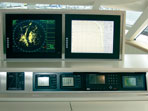| Performance | |
| Safety |
| Living and Working | |
| Medical Assistance |
| Information Technology | |
| Specifications |
|
|
|
|
|
 |
|
The SY Alithia was designed to accommodate eighteen people onboard traveling safely the seven seas, circumnavigating the world and exploring the most remote islands of the planet. |
|||||
|
The safety of people and vessel in the most adverse weather conditions as well as reliable operation in the most distant regions of the planet was a major objective in the design and execution of the construction and the implementation of onboard systems. Only proven, robust, marine environment solutions and components were used. Although pushing the state of the art technology, overall systems were kept at a level of manageable simplicity. The vessel meets the requirements of the Offshore Racing Council. Its hull and deck construction, as well as spars and rig are design approved by Germanischer Lloyd. A noise level of less than 46dB(A) with generator running is achieved through foam and rockwool insulation, sound shielding panels, special mounts and noise insulation capsules. The hull and superstructure are executed in Alustar (aluminium) with flat bottom, plumb vertical and narrow bow, straight sheer line, low stern with reverse transom, low freeboard and low and sleek deckhouse. Weight reduction was enhanced by using a high modulus carbon mast and furling boom and by implementing rudder, steering wheel, transom door, appendages and deckhouse hatches in carbon fiber. A keel fin with short to medium cord in Alustar carries a bolted on lead ballast torpedo of 41 tons. A lifting dagger board in carbon increases the draught from 4,1 to 5,9 meters improving the upwind performance. The deck arrangements are optimized for ease of handling and safety. The deck is unobstructed using flush Rondal hatches in Alustar and carbon, Rondal captive hydraulic winches and a top serviceable double deck for halyards, sheets and running backstays. The teak deck is implemented in a 12mm weight saving construction. The steering system is direct with wire and chain running the block in two gears of five respective eight revolutions or via a Segatron Autopilot. The primary anchoring system is a hydraulic powered roll over CQR anchor. For hurricane conditions an additional removable Paul Luke fisherman anchor can be deployed over a removable carbon bow sprit. |
The Marten Spars Carbon Fibre Rig carries a sail plan of 852m² upwind and 1.316 m² downwind. The mainsail furls into the Leisurefurl boom. A whisker pole allows the stabilization of the genoa on a downwind course. The engine room is spacious with a man's height and vessel's beam. It has feed and exhausts air fans fitted and a fan-coil unit for the work bench. It is optimized for tools, spare parts and documents storage. The vessel is powered by an MTU 422KW/570hp main engine and a Servogear gearbox and propulsion system. Two MTU 45KW generators provide the electrical power. The plant includes water maker and water treatment plant, a bow and stern thruster, Rexroth hydraulic powerpack, air and diving compressor, central air ventilation and conditioning system and a non toxic FM200 fire fighting system. The marine proven electronics include ultra-bright sunlight readable TFT flat screens, Anschutz gyro compasses, Furuno black box radar with three reflectors, Transas navigation system and ASI alarm and monitoring system. Communication systems consist of two VHF radios, one Satcom Mini-M, two Satcom B and a Scotty multiplexer. The latter provides stable video conferencing even in rougher sea conditions. Satcom C and a built in tracking system allows to monitor the movement of the vessel. With a Panasonic PABX plus a marine UHF cordless phone system voice communication covers a line of sight perimeter. The concept of the construction and machine park maximizes seaworthiness and autarchy, so that the most remote passages can be safely undertaken. |
 |
|||
| |
|
© Alithia.de 2002
|